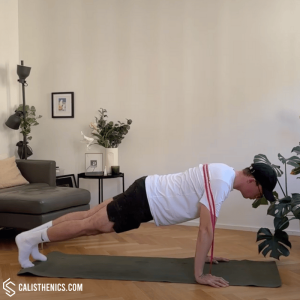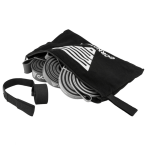Resistance Band Push-Ups
How to do Resistance Band Push-Ups?
Resistance band push-ups are an effective upper-body exercise that targets the chest, shoulders, and triceps. By adding a resistance band, you increase the challenge of a traditional push-up, especially at the top of the movement where band tension is highest. This variation provides a new stimulus for building strength and endurance in the chest and upper body. Resistance band push-ups are easy to perform at home or in the gym, making them a versatile addition to any workout.
Steps to Perform a Proper Resistance Band Push-Up:
1. Position the Resistance Band Across Your Upper Back:
• Loop the resistance band around your upper back, just below your shoulder blades.
• Hold one end of the band in each hand, positioning your hands on the ground where you would normally place them for a push-up.
• Ensure the band is securely anchored around your back, with no slack, and positioned so it won’t slip during the movement.
2. Set Up in a Standard Push-Up Position:
• Place your hands shoulder-width apart on the ground, with your wrists directly under your shoulders.
• Extend your legs back so that you’re in a high plank position, keeping your body in a straight line from head to heels.
• Engage your core, glutes, and legs to stabilize your body, ensuring proper alignment.
3. Lower Into the Push-Up:
• Inhale as you bend your elbows and lower your chest toward the ground.
• Keep your elbows at a 45-degree angle from your body to protect your shoulders and maximize chest engagement.
• Lower until your chest is just above the ground, maintaining tension in the band.
4. Push Back Up to the Starting Position:
• Exhale as you press through your palms, pushing your body back up to the starting position.
• Focus on keeping your core tight and body aligned, resisting the band as you reach the top of the movement.
• Squeeze your chest and triceps at the top, where the band will provide the most resistance.
5. Repeat the Movement:
• Perform the desired number of repetitions, focusing on smooth, controlled movement and maintaining band tension throughout.
Benefits of Resistance Band Push-Ups
• Increases Chest and Triceps Strength: The band adds extra resistance, particularly at the top of the push-up, which helps build strength and muscle in the chest and triceps.
• Improves Core Stability: Maintaining proper plank alignment throughout the push-up enhances core stability and overall body control.
• Portable and Convenient: With only a resistance band required, this exercise is easy to perform at home, while traveling, or in small spaces.
• Promotes Progressive Overload: Resistance bands offer a way to add difficulty to traditional push-ups without weights, promoting strength gains through progressive overload.
• Joint-Friendly: The band provides smooth, controlled resistance that is gentle on the joints, making it suitable for those with shoulder or elbow sensitivities.
• Enhances Functional Strength: Push-ups are a functional movement that builds strength used in daily activities, and adding resistance increases the benefit.
• Accessible for All Fitness Levels: The exercise can be easily modified, with different band strengths available for beginners and advanced users alike.
Common Mistakes to Avoid
• Incorrect Band Placement: Ensure the band is securely anchored across your upper back, not your neck, to prevent discomfort or slippage.
• Sagging Hips: Keep your core engaged to avoid letting your hips sag, which can strain the lower back and reduce effectiveness.
• Flaring Elbows: Avoid letting your elbows flare out to the sides; keep them at a 45-degree angle to protect your shoulders.
• Relying on Momentum: Focus on a controlled push-up movement rather than bouncing or relying on momentum, which reduces effectiveness.
• Allowing the Band to Snap Back: Control the band’s resistance throughout the movement, especially when lowering to the ground, to maximize muscle engagement and prevent injury.
Tips for the proper execution of Resistance Band Push-Ups
Position the Band Securely: Make sure the band is positioned across your upper back, so it won’t slip or move during the exercise.
Engage the Core: Keep your core tight to prevent your hips from sagging, which maintains a straight body line.
Controlled Movements: Perform the exercise slowly and with control, especially when lowering your body to the ground.
Avoid Flaring Elbows: Keep your elbows at a 45-degree angle to your body to protect your shoulders and engage the chest effectively.
Breathing: Inhale as you lower down, and exhale as you press back up, maintaining a steady rhythm and focus.
Muscles worked when doing Resistance Band Push-Ups
Primary Muscles:
•Pectorals (Chest): The primary muscles targeted, responsible for pushing your body up.
•Triceps: Engage to extend the elbows and assist in the push-up movement.
•Deltoids (Shoulders): Particularly the anterior deltoid, helps stabilize and support the movement.
Secondary Muscles:
•Core: The abdominals and obliques engage to stabilize the torso, maintaining proper alignment.
•Serratus Anterior: Assists in stabilizing the shoulder blades during the push-up.
•Glutes and Legs: Engage to maintain a rigid plank position, supporting body alignment and stability.
Primary Muscle(s):
Secondary Muscle(s):

Anterior delt

Triceps
Adjust the difficulty of Resistance Band Push-Ups
How to make Resistance Band Push-Ups harder?
How to make Resistance Band Push-Ups easier?
How to make Resistance Band Push-Ups harder?
To make Resistance Band Push-Ups harder:
-
Use a Heavier Resistance Band: Increase the challenge by using a band with more resistance, requiring greater upper body strength.
-
Slow Down the Eccentric Phase: Take extra time lowering your body to the ground, focusing on control and engagement during the eccentric (lengthening) phase.
-
Add a Hold at the Bottom: Pause at the bottom of the push-up for 2-3 seconds to increase time under tension and maximize muscle engagement.
-
Increase Repetitions or Sets: Perform additional repetitions or sets to build endurance and further challenge your muscles.
How to make Resistance Band Push-Ups easier?
To make Resistance Band Push-Ups easier:
-
Use a Lighter Resistance Band: Start with a band that provides less resistance, allowing you to perform the movement with better form.
-
Perform from Knees: Instead of a full push-up, perform the exercise from your knees to reduce the load and build strength gradually.
-
Limit Range of Motion: Perform partial push-ups, lowering only halfway, to build strength and control.





